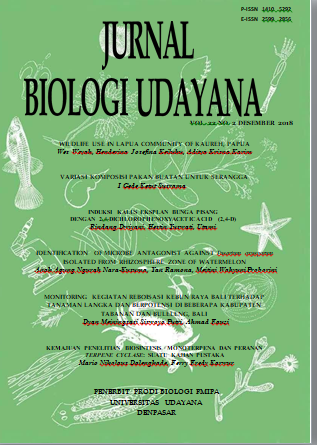CALLUS INDUCTION ON BANANA FLOWER’S EXPLANT IN VITRO USING 2,4-DICHLOROPHENOXYACETIC (2,4-D)
Abstract
ABSTRACT
The objective of the study was to obtain the best 2,4-D concentration on callus induction of the banana flowers in banana propagation using indirect organogenesis method. Kesuna, local banana cultivar obtained from Sembung Gede, Tabanan was used as explant material. Callus induction was performed using 2,4-Dichlorophenoxyacetic acid with concentration of 0; 0.5; 1.0; 1.5 and 2.0 ppm. Each treatment was represented by 3 bottles and each bottle was planted with 3 explants, so each treatment was represented by 9 explants of banana flowers. The results showed that the concentration of 2.0 ppm 2.4-D induced callus with the fastest time and gave the highest percentage of the explants producing callus. The calluses were subsequently subcultured into regeneration medium using 0.5 mg/L Benzylaminopurine (BAP) and 0.005 mg/L Napthaleneaceticacid (NAA). The calluses were subsequently sub-cultured into a regeneration medium using 0.5 ppm (BAP) and 0.005 ppm Naphthalene acetic acid (NAA) to induce shoots and roots and performed plantlets.
Keywords: 2,4-Dichlorophenoxyacetic acid, banana’s flowers, callus





